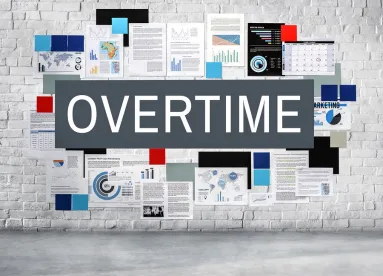Upon further reflection, a panel of the U.S. Court of Appeals for the Fifth Circuit has determined that paying an employee a set amount for each day that he works (i.e. on a “day rate” basis) does not satisfy the “salary basis” component required to qualify as overtime-exempt under the Fair Labor Standards Act (FLSA), even if by working a single hour in a given week, the employee will earn at least the weekly minimum salary (currently, $684.00) required to satisfy the exemption. Hewitt v. Helix Energy Solutions Group, Inc., 2020 U.S. App. LEXIS 12554 (5th Cir. Apr. 20, 2020).
In so holding, the Court of Appeals reversed the position another panel initially took in an opinion last year but subsequently withdrew, deciding the case on other grounds. Faludi v. U.S. Shale Solutions, L.L.C., 936 F.3d 215 (5th Cir. 2019), op. withdrawn, 950 F.3d 269 (5th Cir. 2020). The Fifth Circuit has now aligned itself with the Sixth Circuit in concluding that a day-rate payment scheme fails to meet the FLSA’s salary-basis test. See Hughes v. Gulf Interstate Field Servs., Inc., 878 F.3d 183, 189 (6th Cir. 2017). The Fifth Circuit includes the federal courts in Texas, Mississippi, and Louisiana, while the Sixth Circuit includes the federal courts in Michigan, Ohio, Kentucky, and Tennessee.
In Hewitt, the plaintiff worked on an offshore oil rig for periods of about a month at a time, known as “hitches.” The company paid the plaintiff a set amount for each day that he worked, and he received bi-weekly paychecks. Despite earning over $200,000 during each of the two years he was employed, and admittedly being paid at least $455.00 for each week in which he worked (the minimum salary required for exempt status during the time of his employment), the plaintiff filed suit, claiming he was entitled to overtime for each week he worked in excess of 40 hours. In response, the company asserted that he was exempt from overtime, under either the “executive” exemption or as a “highly compensated employee.” The district court agreed that the plaintiff was exempt on either basis, and granted summary judgment to the employer. The plaintiff appealed and the Fifth Circuit reversed.
Both the “white collar” (executive, administrative, and professional) exemptions and the highly compensated employee exemption involve a “duties test” and a “salary test.” The salary test includes two components: (1) the employer must pay the employee a minimum per-week rate, and (2) the employer must pay the employee on a “salary basis.” At issue on appeal was whether the employer demonstrated that the “salary basis” component was met. The pertinent U.S. Department of Labor (DOL) regulation provides:
An employee will be considered to be paid on a ‘salary basis’ within the meaning of this part if the employee regularly receives each pay period on a weekly, or less frequent basis, a predetermined amount constituting all or part of the employee’s compensation, which amount is not subject to reduction because of variations in the quality or quantity of the work performed.
29 C.F.R. § 541.602(a).
“Broadly speaking, then,” the Court of Appeals stated, “Section 541.602(a) requires that an employee receive for each pay period a ‘predetermined amount’ calculated on a ‘weekly, or less frequent’ pay period.” In other words, concluded the Court, the “employee [must] know the amount of his compensation for each weekly (or less frequent) pay period during which he works, before he works.” (emphasis added).
In this case, because the plaintiff was paid a day rate only for the actual days he worked in a given week, he could only determine what his pay would be after he completed the pay period. Thus, he did not receive a “predetermined amount” for each bi-weekly pay period. Accordingly, held the Court of Appeals, he was not paid on a “salary basis” under DOL regulations. The Court added that this conclusion was supported by the language of Section 541.602(a)(1) of the regulations, which states that “an exempt employee must receive the full salary for any week in which the employee performs any work without regard to the number of days or hours worked” (emphasis added) and that paying an employee only for the days he works, as was the case with the plaintiff, “cannot be squared with this provision.”
Notably, one issue that did not play a significant role in this case was the potential applicability of Section 541.604(b) of the regulations. That section provides in part:
An exempt employee’s earnings may be computed on an hourly, a daily or a shift basis, without losing the exemption or violating the salary basis requirement, if the employment arrangement also includes a guarantee of at least the minimum weekly required amount paid on a salary basis regardless of the number of hours, days or shifts worked, and a reasonable relationship exists between the guaranteed amount and the amount actually earned. The reasonable relationship test will be met if the weekly guarantee is roughly equivalent to the employee’s usual earnings at the assigned hourly, daily or shift rate for the employee’s normal scheduled workweek. Thus, for example, an exempt employee guaranteed compensation of at least $725 for any week in which the employee performs any work, and who normally works four or five shifts each week, may be paid $210 per shift without violating the $684-per-week salary basis requirement.
In this case, the employer did not argue that the plaintiff was guaranteed a minimum weekly amount that reasonably approximated what he usually earned. On the contrary, the employer conceded that this provision was inapplicable to the facts at hand. Moreover, as the Court already had held, the plaintiff was not paid “on a salary basis.” Nevertheless, as the regulations note, such circumstances may allow an employer to implement a salary-based pay system with a daily-rate component, without abrogating an employee’s exempt status.





 />i
/>i

